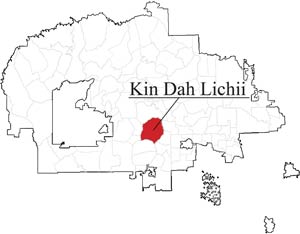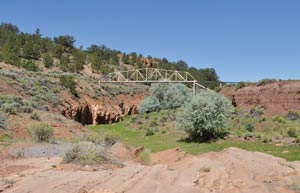A bridge not far enough
Kin Dah Lichii chapter is divided by a creek
By Cindy Yurth
Tséyi' Bureau
KIN DAH LICHII, Ariz., June 20, 2013
(Editor's note: In an effort to chronicle the beauty and diversity of the Navajo Nation, as well as its issues, the Navajo Times has committed to visiting all 110 chapters in alphabetical order. This is the 40th in the series.)


I f you're of the Kinlichiinii Clan, you may think of this picturesque chapter of red rock canyons as your ancestral home. But you'd be wrong.
"Our ruin doesn't have anything to do with the clan," stated Kin Dah Lichii Chapter President Benjamin Curley.
In fact, in listing the major clans in this area, Kinlichiinii doesn't even come up.
"There may be some," Curley conceded, "but they'd be from somewhere else."
Kin Dah Lichii, "Red House," is named after a red sandstone Anasazi ruin that is now a Navajo Nation tribal park.
At least, a sign at the ruin says it's a tribal park. It's not listed on the Navajo Parks and Recreation Department's Web site, and the employee who answered the department's phone had never heard of it.
This could be part of Kin Dah Lichii Chapter's problem.
"We have a lot of Anasazi ruins here, not just the main one," said Chapter Manager Lavina Curley, who also happens to be Benjamin Curley's wife. "But tourists don't know about them."
The chapter has discussed razing the burned-out trading post on Arizona Highway 264 and replacing it with a visitors' center, from which the ruins and beautiful red rock scenery could be accessed on foot or horseback. But so far, it's just a dream.
"We have a lot of dreams," Lavina Curley said.
Let it not be thought, however, that all the chapter administration does is dream. The chapter has been certified since 2010, and since the new chapter officials took office in January, Lavina Curley has applied for a total of more than $1.5 million in grants from the Navajo Nation, for bathroom additions, two power lines and a new Head Start building.
Kin Dah Lichii is also working on rural addressing, reclaiming fallow farm plots and business site leases, writing an eminent domain ordinance, building scattered housing for elders and planning a new chapter house, senior citizens center, and day care.
Ninety percent of Kin Dah Lichii's 6,000 residents have running water and 75 percent have electricity, and the chapter is working hard to serve the rest.
While we were reporting on this story, the phone company was upgrading the chapter's communications tower to supply a 3G network to users of smart phones.
This is a chapter that dreams big, and is prepared to follow through.
Alas, Kin Dah Lichii's most important dream seems entirely out of its hands. For 25 years, the chapter has been waiting for a new bridge across the Kin Dah Lichii Creek.
That's when the old bridge was condemned by the Bureau of Indian Affairs. The bridge was removed last November, but has yet to be replaced.
Under Joe Shirley's administration, the committee that prioritizes BIA road projects had the Kin Dah Lichii road and its accompanying bridge listed as No. 1.
Since then, the committee's makeup has changed, "and now we're down to No. 5," griped Lavina Curley. "The bridge itself is at No. 9."
It may not sound like a huge deal, but 27 families are stranded every time it rains or snows.
"For them, it's uphill all ways," Curley said. "If it's wet, the kids have to walk across and meet the (school) bus on the other side. We had a fire on that side, and the fire truck couldn't get across. People had to walk across carrying gallon jugs of water."
Technically, the road is closed. But it doesn't take much to find the self-made detour around the sign.
"People are going around it," Benjamin Curley said. "The BIA says they closed the road because of liability, but it's a liability issue the way people are driving around it."
During a flood, an elderly couple's car was washed downstream until it came to rest against a post, according to Curley.
Three times, the chapter has taken matters into its own hands and put in a culvert. And three times, the culvert has washed away in high water.
So Kin Dah Lichii waits on the BIA. And dreams. And tries to stay positive.
"Everything," reasons Lavina Curley, "starts with a dream."
Contact Cindy Yurth at cyurth@navajotimes.com.
Kin Dah Lichii at a Glance
Name - "Kin Dah Lichii" translates to "Red House" in honor of a well preserved Anasazi ruin built of local red sandstone. The naturally flat, red stone was also used to build the original 1932 boarding school and the chapter house.
Population - about 6,000. The voting district that includes Kin Dah Lichii is the largest on the Navajo Nation.
Land area - 234,342 acres
Assets - timber, a year-round creek, farm fields, piñon nuts, a BIE contract school and a charter school, historic buildings, well preserved Anasazi ruins, access to a state highway
Problems - feral animals, a creek with no bridge across it, illegal dumping in the chapter's many washes and canyons, vandalism
Major clans - Oddly, you won't find many Kin Lichíi'niis here. They are named after a different ruin. Instead look for Tódích'íi'nii, Ma'ii Deeshgiizhnii, Tábaahá, Tó 'Aheedlíinii, 'Áshiihí, Tsi'najinii, Tazhii'nii and Kin Yaa'áanii.
Famous sons and daughters - Dr. Samuel Billison, a Navajo Code Talker who obtained a doctorate in education and helped reorganize the reservation's education system under the Bureau of Indian Affairs; current Navajo Times Editor Candace Begody, the newspaper's youngest and first female editor.

